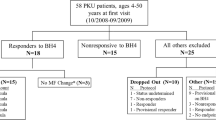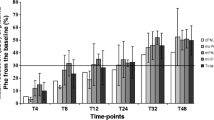Abstract
Background
Tetrahydrobiopterin (BH4)-sensitive phenylketonuria (PKU) can be treated with sapropterin dihydrochloride. We studied metabolic control and health-related quality of life (HRQoL) in PKU patients treated with BH4.
Subjects and methods
Based on the review of neonatal BH4 test results and mutation analysis in 41 PKU patients, 19 were identified as potentially BH4-sensitive (9 females, 10 males, age 4–18 years). We analyzed phenylalanine (phe) concentrations in dried blood samples, nutrition protocols, and HRQoL questionnaires (KINDL®) beginning from 1 year before, during the first 42 days, and after 3 months of BH4 therapy.
Results
Eight BH4-sensitive patients increased their phe tolerance (629 ± 476 vs. 2131 ± 1084 mg, p = 0.006) while maintaining good metabolic control (phe concentration in dried blood 283 ± 145 vs. 304 ± 136 μM, p = 1.0). Six of them were able to stop dietary protein restriction entirely. BH4-sensitive patients had average HRQoL scores that were comparable to age-matched healthy children. There was no improvement in HRQoL scores after replacing classic dietary treatment with BH4 supply, although personal reports given by the patients and their parents suggest that available questionnaires are inappropriate to detect aspects relevant to inborn metabolic disorders.
Discussion
BH4 can allow PKU patients to increase their phe consumption significantly or even stop dietary protein restrictions. Unexpectedly, this does not improve HRQoL as assessed with KINDL®, partly due to high scores even before BH4 therapy. Specific questionnaires should be developed for inborn metabolic disorders.

Similar content being viewed by others
References
Awiszus D, Unger I (1990) Coping with PKU: results of narrative interviews with parents. Eur J Pediatr 149(Suppl 1):S45–S51
Bernegger C, Blau N (2002) High frequency of tetrahydrobiopterin-responsiveness among hyperphenylalaninemias: a study of 1,919 patients observed from 1988 to 2002. Mol Genet Metab 77:304–313
Bik-Multanowski M, Didycz B, Mozrzymas R et al (2008) Quality of life in noncompliant adults with phenylketonuria after resumption of the diet. J Inherit Metab Dis 31(Suppl 2):S415–418
Bilginsoy C, Waitzman N, Leonard CO, Ernst SL (2005) Living with phenylketonuria: perspectives of patients and their families. J Inherit Metab Dis 28:639–649
Bosch AM, Tybout W, van Spronsen FJ, de Valk HW, Wijburg FA, Grootenhuis MA (2007) The course of life and quality of life of early and continuously treated Dutch patients with phenylketonuria. J Inherit Metab Dis 30:29–34
Brumm VL, Bilder D, Waisbren SE (2010) Psychiatric symptoms and disorders in phenylketonuria. Mol Genet Metab 99(Suppl 1):S59–S63
Burgard P, Rey F, Rupp A, Abadie V, Rey J (1997) Neuropsychologic functions of early treated patients with phenylketonuria, on and off diet: results of a cross-national and cross-sectional study. Pediatr Res 41:368–374
Burlina A, Blau N (2009) Effect of BH(4) supplementation on phenylalanine tolerance. J Inherit Metab Dis 32:40–45
Burnett JR (2007) Sapropterin dihydrochloride (Kuvan/phenoptin), an orally active synthetic form of BH4 for the treatment of phenylketonuria. IDrugs 10:805–813
Burton BK, Bausell H, Katz R, Laduca H, Sullivan C (2010) Sapropterin therapy increases stability of blood phenylalanine levels in patients with BH4-responsive phenylketonuria (PKU). Mol Genet Metab 101:110–114
Ceglarek U, Muller P, Stach B, Buhrdel P, Thiery J, Kiess W (2002) Validation of the phenylalanine/tyrosine ratio determined by tandem mass spectrometry: sensitive newborn screening for phenylketonuria. Clin Chem Lab Med 40:693–697
Elsas LJ, Greto J, Wierenga A (2011) The effect of blood phenylalanine concentration on Kuvan response in phenylketonuria. Mol Genet Metab 102:407–412
Fiege B, Blau N (2007) Assessment of tetrahydrobiopterin (BH4) responsiveness in phenylketonuria. J Pediatr 150:627–630
Fiori L, Fiege B, Riva E, Giovannini M (2005) Incidence of BH4-responsiveness in phenylalanine-hydroxylase-deficient Italian patients. Mol Genet Metab 86(Suppl 1):S67–S74
Friedman D, Holmbeck GN, Jandasek B, Zukerman J, Abad M (2004) Parent functioning in families of preadolescents with spina bifida: longitudinal implications for child adjustment. J Fam Psychol 18:609–619
Gassio R, Campistol J, Vilaseca MA, Lambruschini N, Cambra FJ, Fuste E (2003) Do adult patients with phenylketonuria improve their quality of life after introduction/resumption of a phenylalanine-restricted diet? Acta Paediatr 92:1474–1478
Hartmann B (2009) Bundeslebensmittelschluessel. http://www.bls.nvs2.de/index.php?id=37. Max-Rubner-Institut, Karlsruhe
Hatzmann J, Heymans HS, Carbonell A, van Praag BM, Grootenhuis MA (2008) Hidden consequences of success in pediatrics: parental health-related quality of life–results from the Care Project. Pediatrics 122:e1030–e1038
Hatzmann J, Maurice-Stam H, Heymans HS, Grootenhuis MA (2009) A predictive model of health related quality of life of parents of chronically ill children: the importance of care-dependency of their child and their support system. Health Qual Life Outcomes 7:72
Hennermann JB, Buhrer C, Blau N, Vetter B, Monch E (2005) Long-term treatment with tetrahydrobiopterin increases phenylalanine tolerance in children with severe phenotype of phenylketonuria. Mol Genet Metab 86(Suppl 1):S86–S90
Kure S, Hou DC, Ohura T et al (1999) Tetrahydrobiopterin-responsive phenylalanine hydroxylase deficiency. J Pediatr 135:375–378
Landolt MA, Nuoffer JM, Steinmann B, Superti-Furga A (2002) Quality of life and psychologic adjustment in children and adolescents with early treated phenylketonuria can be normal. J Pediatr 140:516–521
Lee P, Treacy EP, Crombez E et al (2008) Safety and efficacy of 22 weeks of treatment with sapropterin dihydrochloride in patients with phenylketonuria. Am J Med Genet A 146A:2851–2859
Levy HL, Waisbren SE (1994) PKU in adolescents: rationale and psychosocial factors in diet continuation. Acta Paediatr Suppl 407:92–97
Lindner M, Haas D, Mayatepek E, Zschocke J, Burgard P (2001) Tetrahydrobiopterin responsiveness in phenylketonuria differs between patients with the same genotype. Mol Genet Metab 73:104–106
Macdonald A (2000) Diet and compliance in phenylketonuria. Eur J Pediatr 159(Suppl 2):S136–S141
Macdonald A, Gokmen-Ozel H, van Rijn M, Burgard P (2010) The reality of dietary compliance in the management of phenylketonuria. J Inherit Metab Dis 33:665–670
Muntau AC, Roschinger W, Habich M et al (2002) Tetrahydrobiopterin as an alternative treatment for mild phenylketonuria. N Engl J Med 347:2122–2132
Mütze U, Roth A, Weigel JF et al (2011) Transition of young adults with phenylketonuria from pediatric to adult care. J Inherit Metab Dis 34(3):701–709
Pey AL, Perez B, Desviat LR et al (2004) Mechanisms underlying responsiveness to tetrahydrobiopterin in mild phenylketonuria mutations. Hum Mutat 24:388–399
Pietz J, Dunckelmann R, Rupp A et al (1998) Neurological outcome in adult patients with early-treated phenylketonuria. Eur J Pediatr 157:824–830
Prince AP, McMurray MP, Buist NR (1997) Treatment products and approaches for phenylketonuria: improved palatability and flexibility demonstrate safety, efficacy and acceptance in US clinical trials. J Inherit Metab Dis 20:486–498
Ravens-Sieberer U, Ellert U, Erhart M (2007) Health-related quality of life of children and adolescents in Germany. Norm data from the German Health Interview and Examination Survey (KiGGS). Bundesgesundheitsblatt Gesundheitsforschung Gesundheitsschutz 50:810–818
Scriver CR, Kaufman S, Eisensmith RC, Woo SLC (1998) The hyperphenylalaninemias. In: Scriver RC, Beaudet AL, Sly WS, Valle D (eds) The metabolic and molecular basis of inherited disease. McGraw-Hill, New York, pp 1015–1075
Shintaku H, Kure S, Ohura T et al (2004) Long-term treatment and diagnosis of tetrahydrobiopterin-responsive hyperphenylalaninemia with a mutant phenylalanine hydroxylase gene. Pediatr Res 55:425–430
Simon E, Schwarz M, Roos J et al (2008) Evaluation of quality of life and description of the sociodemographic state in adolescent and young adult patients with phenylketonuria (PKU). Health Qual Life Outcomes 6:25
Stemerdink BA, Kalverboer AF, van der Meere JJ et al (2000) Behaviour and school achievement in patients with early and continuously treated phenylketonuria. J Inher Metab Dis 23:548–562
Ten Hoedt AE, Maurice-Stam H, Boelen CC et al (2011) Parenting a child with phenylketonuria or galactosemia: implications for health-related quality of life. J Inherit Metab Dis 34:391–398
Thompson AJ, Smith I, Brenton D et al (1990) Neurological deterioration in young adults with phenylketonuria. Lancet 336:602–605
Trefz FK, Burton BK, Longo N et al (2009) Efficacy of sapropterin dihydrochloride in increasing phenylalanine tolerance in children with phenylketonuria: a phase III, randomized, double-blind, placebo-controlled study. J Pediatr 154:700–707
Wallander JL, Varni JW (1998) Effects of pediatric chronic physical disorders on child and family adjustment. J Child Psychol Psychiatry 39:29–46
Weglage J, Funders B, Wilken B et al (1992) Psychological and social findings in adolescents with phenylketonuria. Eur J Pediatr 151:522–525
Zurfluh MR, Zschocke J, Lindner M et al (2008) Molecular genetics of tetrahydrobiopterin-responsive phenylalanine hydroxylase deficiency. Hum Mutat 29:167–175
Acknowledgments
The authors would like to thank the patients and their families for their interest and participation. The help by the nurses at the hospital’s outpatient clinic is as much appreciated as that by the technicians in the department’s laboratory.
This work was supported by an investigator-initiated, unrestricted research grant from Merck-Serono GmbH.
Author information
Authors and Affiliations
Corresponding author
Additional information
Communicated by: Anita MacDonald
Rights and permissions
About this article
Cite this article
Ziesch, B., Weigel, J., Thiele, A. et al. Tetrahydrobiopterin (BH4) in PKU: effect on dietary treatment, metabolic control, and quality of life. J Inherit Metab Dis 35, 983–992 (2012). https://doi.org/10.1007/s10545-012-9458-1
Received:
Revised:
Accepted:
Published:
Issue Date:
DOI: https://doi.org/10.1007/s10545-012-9458-1




